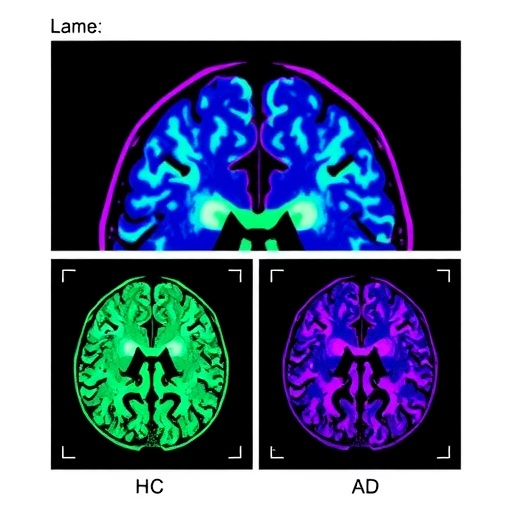A groundbreaking study led by researchers Hsiao, Lin, and Chang has made significant strides in neuroimaging, particularly in the realms of health monitoring for conditions like Healthy Control (HC), Mild Cognitive Impairment (MCI), and Alzheimer’s Disease (AD). Utilizing advanced deep learning techniques, the researchers explored the potential of computed tomography (CT) scans to accurately differentiate between these critical health conditions. Their findings were published in the Journal of Medical and Biological Engineering, marking a notable contribution to the understanding and diagnosis of neurodegenerative diseases.
The study addresses a pressing challenge in the medical community: the early detection and classification of Alzheimer’s Disease and its precursors. Traditional diagnostic methods often rely on subjective assessments and can be influenced by various factors, leading to potential misdiagnoses or delayed treatments. The authors’ innovative approach employs deep learning algorithms, harnessing the power of artificial intelligence (AI) to enhance diagnostic accuracy, thereby revolutionizing the landscape of neurodegenerative disease diagnostics.
By integrating deep learning with CT imaging, the researchers developed a model capable of analyzing intricate patterns within brain scans that may not be immediately visible to human eyes. This AI-driven model was trained on a dataset comprising thousands of CT images, allowing it to learn the subtle differences indicative of HC, MCI, and AD. The methodology also tackled the inherent variability in human brain anatomy and the stage of disease which can complicate the diagnostic process. The researchers’ model promises to provide a robust solution to these complexities.
An impressive aspect of the study is its emphasis on the explainability of the AI model. The researchers prioritized not only accuracy but also the interpretability of the findings. Understanding the reasons behind a model’s predictions can significantly aid clinicians in making more informed decisions regarding patient care. By employing techniques such as heatmaps, the researchers could visually represent the specific areas of the brain that contributed most significantly to the classification, thus providing essential insights for clinical practitioners.
Furthermore, the research highlights the efficiency of deep learning algorithms in processing large datasets. Given the rising prevalence of neurodegenerative diseases globally, the need for scalable and cost-effective diagnostic tools has never been more critical. With the capacity to analyze thousands of images within a fraction of the time it would take a human, this study underscores the transformative potential of AI in medicine.
Additionally, the implications of this research extend beyond mere classification. With the enhancement of diagnostic capabilities, there is a corresponding hope for improving patient outcomes through earlier detection and customized treatment strategies. The study can pave the way for proactive monitoring of individuals at risk for cognitive decline, enabling timely interventions that may slow disease progression and enhance the quality of life.
As the world grapples with an aging population and the accompanying rise in age-related illnesses, such advanced methodologies in medical diagnostics are essential. The adoption of AI tools such as those developed in this study could signify a paradigm shift in how neurological conditions are diagnosed and treated. It lays the groundwork for future research, pushing the boundaries of current understanding and fostering a more personalized approach to patient care.
Moreover, as healthcare systems around the globe continue to evolve, the integration of AI in clinical workflows highlights the importance of collaboration between technologists and healthcare professionals. Such partnerships are crucial to ensure that the tools developed are not only scientifically sound but also applicable in real-world settings. The researchers advocate for continuous collaboration to refine these models and validate their applicability across diverse populations.
Despite the promising results exhibited in this study, the authors emphasize the necessity of continuous improvement and verification of the technology. They advocate for larger-scale studies that encompass varied demographics to further explore the efficacy of the AI model in different populations. This step is crucial for ensuring that the technology is both widely applicable and sensitive to the biological diversity observed in human populations.
In conclusion, the study by Hsiao and colleagues represents a pivotal moment in the intersection of artificial intelligence and medical diagnostics. It highlights how technology can be leveraged to better understand complex medical conditions and fosters hope for more effective interventions. As we move further into the era of personalized medicine, the ability to adopt cutting-edge technology into clinical practices will be paramount.
In a world where the intersection of technology and health is becoming increasingly intertwined, the advancements made in this study could very well herald a new age of diagnostic precision. Organizing future efforts towards refining these tools will surely remain critical in the years to come. The ongoing research and discussions around such innovations will continue to energize the scientific community and inspire new pathways for treating neurodegenerative diseases.
As neuroimaging techniques and AI continue to evolve, we can anticipate even more groundbreaking studies that could further enrich our understanding of the human brain and the complexities of cognitive impairments. The potential for these technologies to influence not just diagnosis, but the broader landscape of healthcare, is immense.
The ongoing collaboration between scientists and clinicians will be instrumental in closing the gap between research and practical application. As the capabilities of deep learning algorithms expand, the future of diagnosing and managing neurodegenerative conditions seems brighter than ever, allowing for a proactive rather than reactive approach to cognitive health. The dissemination of such research is vital, as it encourages a communal effort towards understanding, diagnosing, and ultimately treating cognitive disorders that affect millions worldwide.
Subject of Research: Classification of Healthy Control, Mild Cognitive Impairment, and Alzheimer’s Disease using Deep Learning and CT Imaging.
Article Title: Classification of HC, MCI, and AD Based on CT Using Deep Learning.
Article References:
Hsiao, IT., Lin, KJ., Chang, CC. et al. Classification of HC, MCI, and AD Based on CT Using Deep Learning.
J. Med. Biol. Eng. (2025). https://doi.org/10.1007/s40846-025-00985-w
Image Credits: AI Generated
DOI:
Keywords: Neuroimaging, Deep Learning, Alzheimer’s Disease, Mild Cognitive Impairment, AI in Healthcare, Medical Diagnostics, CT Imaging, Brain Health.




